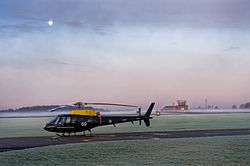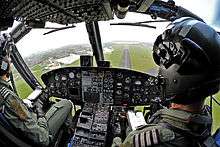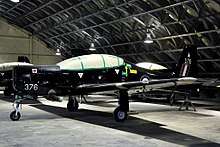RAF Shawbury
| RAF Shawbury | |||||||||
|---|---|---|---|---|---|---|---|---|---|
| Near Shawbury, Shropshire in England | |||||||||
 An RAF Squirrel Helicopter at RAF Shawbury. | |||||||||
 | |||||||||
 RAF Shawbury Shown within Shropshire | |||||||||
| Coordinates | 52°47′53″N 002°40′05″W / 52.79806°N 2.66806°WCoordinates: 52°47′53″N 002°40′05″W / 52.79806°N 2.66806°W | ||||||||
| Type | Royal Air Force station | ||||||||
| Site information | |||||||||
| Owner | Ministry of Defence | ||||||||
| Operator |
Royal Flying Corps (1917–1918) Royal Air Force (1918-1920 & 1938–present) | ||||||||
| Controlled by | No. 22 Group (Training) | ||||||||
| Website |
www | ||||||||
| Site history | |||||||||
| Built | 1916, rebuilt in 1937 | ||||||||
| In use | 1917–1920, 1938–Present | ||||||||
| Garrison information | |||||||||
| Current commander | Group Captain R S Norris | ||||||||
| Occupants |
| ||||||||
| Airfield information | |||||||||
| Identifiers | ICAO: EGOS, WMO: 03414 | ||||||||
| Elevation | 76 metres (249 ft) AMSL | ||||||||
| |||||||||
Royal Air Force Shawbury otherwise known as RAF Shawbury is a Royal Air Force station near the village of Shawbury in Shropshire in the West Midlands of England.
History
The First World War
The station at Shawbury was first used for military flying training in 1917 by the Royal Flying Corps. No. 29 (Training) Wing formed on 1 September 1917 with three training squadrons, No. 10 Squadron, No. 29 (Australian) (Training) Squadron and No. 67 Squadron.[1] Several different types of aircraft were operated which caused difficulties with training and maintenance. Two of the squadrons combined to form 9 Training Depot Station on 1 March 1918, the other moving to Gloucestershire.[2][3] Training continued on a more organised basis until the end of the war.[4]
The airfield closed in May 1920 when strength of the RAF was drastically reduced. The hangars and other buildings were demolished and the land was returned to agricultural use.[4]
The Second World War
In February 1938 the station was reactivated as a training establishment, firstly used by No. 11 Service Flying Training School and an Aircraft Storage Unit (ASU) which was operated by No. 27 Maintenance Unit.[5][6] The airfield also had Relief Landing Grounds at RAF Bridleway Gate and RAF Bratton, with additional satellite landing grounds at RAF Hinstock, RAF Hodnet and RAF Weston Park.[7] Shawbury primarily prepared pilots for operational squadrons, with the main aircraft being the Airspeed Oxford. In 1944 it became the home of the Central Navigation School, which had moved from RAF Cranage in Cheshire, primarily concerned with improving the standard of air navigation in bombers.[6]
Post WW2
In 1950, the School of Air Traffic Control moved to Shawbury, combining to form the Central Navigation and Control School.[8] In 1963, the Navigation Wing moved to RAF Manby in Lincolnshire.
No. 27 Maintenance Unit continued its aircraft storage and scrapping work at Shawbury until disbandment in July 1972.[9]
Shawbury became home to No. 2 Flying Training School in 1976, tasked with basic and advanced helicopter training and operating the Aerospatiale Gazelle and Westland Wessex in those roles respectively.[10]
In the 1980s Shawbury provided 'pre-employment training' courses for RAF groundcrew being posted from fixed-wing to rotary-wing squadrons.
1990's and 2000's

No. 2 Flying Training School was disbanded in March 1997 so that in April 1997 the station could start providing training of helicopter pilots for all three of the UK's armed services, under the newly formed Defence Helicopter Flying School.[11]
Between 2001 and 2014 Shawbury was home to the Assault Glider Trust, a charity building a non-flying replica Horsa glider for museum display.[12]
The station's physical recreation training centre, named the Jubilee Hall Sports and Fitness Centre to mark the Diamond Jubilee of Elizabeth II, was opened by Prince Michael of Kent on 24 April 2012.[13]
In April 2016 the Central Air Traffic Control School (CATCS) was renamed the School of Air Operations Control (SAOC) and came under the control of the newly created Defence College of Airspace Control.[14]
Role and operations
RAF Shawbury's mission statement is "To provide a safe, efficient, and effective airfield base environment; to enable and support, commanded, lodged and parented units; and to deliver wider Defence and RAF tasks as directed".[15]
The station is home to the Central Air Traffic Control School.
Defence Helicopter Flying School
The Defence Helicopter Flying School (DHFS) provides basic helicopter pilot training for the RAF, Royal Navy and Army Air Corps (AAC), as well as foreign and commonwealth countries. The DHFS comprises three flying squadrons, No. 660 Squadron (AAC) and 705 Naval Air Squadron operating the Squirrel HT1 (Eurocopter AS350BB) and No. 60 Squadron of the RAF operating the Griffin HT1 (Bell 412 EP). The helicopters are maintained by contractor, FB Heliservices Ltd, (now part of Cobham plc) which also provide 40% of the flying instructors.[16]
Central Flying School (Helicopter) Squadron
The RAF Central Flying School (Helicopter) Squadron provides Qualified Helicopter Instructor and Qualified Helicopter Crewman Instructor (QHI/QHCI) training for the Squirrel and Griffin. The unit trains crews from all three UK armed services as well as foreign air arms.[17]
Aircraft Maintenance and Storage Unit

Several RAF aircraft types are stored in long-term reserve at RAF Shawbury. These aircraft are stored in four specially de-humidified hangars at different states of readiness and can be brought back into active service if required. Other aircraft types which are no longer required for operational service are also stored pending their disposal. The unit is operated by FB Heliservices, part of Cobham.[18]
Based Units
Flying and notable non-flying units based at RAF Shawbury.[19]
Royal Air Force
- Aircraft Maintenance and Storage Unit (operated by FB Heliservices)
- Defence Helicopter Flying School
- No. 60 (Reserve) Squadron - Bell Griffin HT1
- No. 660 Squadron (Army Air Corps) - Eurocopter Squirrel HT1
- No. 705 Naval Air Squadron - Eurocopter Squirrel HT1
- Defence College of Airspace Control
- Central Flying School
- Central Flying School (Helicopter) Squadron
Future
Juno and Jupiter
In 2016 the Ministry of Defence selected Ascent Flight Training to deliver the UK Military Flying Training System, a 25-year contract to provide fixed-wing elementary, basic, multi-engine and fast-jet pilot training, rear crew training and helicopter training to the UK military. Subsequently, Ascent selected Airbus Helicopters to supply thirty-two helicopters to replace the DHFS Squirrel and Griffin aircraft. Airbus will provide twenty-nine H135 airframes, to be known as Juno HT1 and three H145 airframes, known as Jupiter HT1. Due to the reduced requirement for search and rescue (SAR) training, following the privatisation of SAR provision, only three of the larger H145 aircraft are required, compared to the larger number of Griffins operated. The new fleet is entirely twin-engine, replacing the single engine Squirrel in service, as nearly all helicopters now operated by the UK military are twin-engined, apart from the Gazelle AH1, which is due for retirement. Ascent expects to train 286 aircrew a year.[20]
The first two Juno and a Jupiter were delivered to Shawbury on 3 April 2017. Deliveries will continue throughout 2017/18 and full training capability is expected by April 2018.[21]
Ministry of Defence personnel relocation
It was announced by the Ministry of Defence (MOD) in November 2016 that MOD staff currently based at 1300 Parkway in Bristol would be relocated to Shawbury by 2020.[22]
See also
References
Citations
- ↑ Leach, Kim, ed. (January 2017). "100 years since the formation of the first flying squadron". Aries; The magazine of RAF Shawbury. Shropshire: RAF Shawbury (1): 6–7. OCLC 921875505.
- ↑ "Station History".
- ↑ "RAF Stations, West Midlands".
- 1 2 Smith, 1981, p. 164
- ↑ Lake 1999, p. 108.
- 1 2 Delve 2007, p. 269.
- ↑ Francis 2010, p. 27.
- ↑ Lake 1999, pp. 46-47.
- ↑ Delve 2007, p. 271.
- ↑ Lake 1999, p. 104.
- ↑ Lake, Alan (1999). Flying units of the RAF : the ancestry, formation and disbandment of all flying units from 1912. Shrewsbury: Airlife. p. 104. ISBN 1-84037-086-6.
- ↑ "Assault Glider Trust Timeline". Assault Glider Trust. 20 January 2017. Retrieved 23 November 2017.
- ↑ "Jubilee Sports Hall opened at RAF Shawbury". Ministry of Defence. 7 June 2012. Retrieved 3 July 2012.
- ↑ "A New School for RAF Shawbury". RAF Shawbury. 7 April 2016. Archived from the original on 2016-04-13. Retrieved 23 November 2017.
- ↑ "RAF Shawbury". RAF Shawbury. Retrieved 23 November 2017.
- ↑ "DHFS". RAF Shawbury. Retrieved 23 November 2017.
- ↑ "CFSH". RAF Shawbury. Retrieved 23 November 2017.
- ↑ "Contractors". RAF Shawbury. Retrieved 23 November 2017.
- ↑ "About Us". RAF Shawbury. Retrieved 2 August 2017.
- ↑ "UKMFTS Rotary Wing Aircraft Service Provision Contract Awarded". Aerossurance. Retrieved 18 January 2017.
- ↑ "New aircraft arrive at RAF Shawbury". RAF Shawbury. Retrieved 10 April 2017.
- ↑ "RAF Shawbury airbase to be extended as units move in from Bristol". Shropshire Star. 9 November 2016. Retrieved 23 November 2017.
Bibliography
- Delve, Ken (2007). The military airfields of Britain; Wales and West Midlands. Crowood Press. ISBN 978-1-861269-17-1.
- Francis, P. 20th Century Military Archaeology Issue 1: Airfield Defence. ARP & AiX-ARG Archive Limited. ISBN 978-0-9521847-0-6.
- Lake, Alan (1999). Flying units of the RAF; the ancestry, formation and disbandment of all flying units from 1912. Airlife. ISBN 1-84037-086-6.
- Smith, David. J. (1981). Action Stations, 3 :Military Airfields of Wales and the North-West. Patrick Stephens Limited. ISBN 0-85059-485-5.
External links
| Wikimedia Commons has media related to RAF Shawbury. |
- Station home page
- The Assault Glider Trust
- Defence Helicopter Flying School (DHFS)
- Airport information for EGOS at World Aero Data. Data current as of October 2006.
